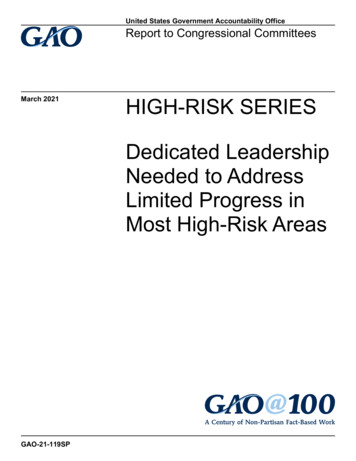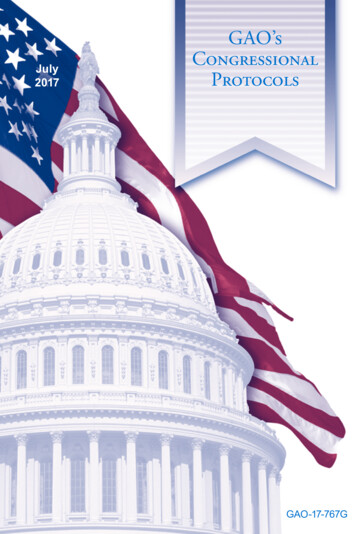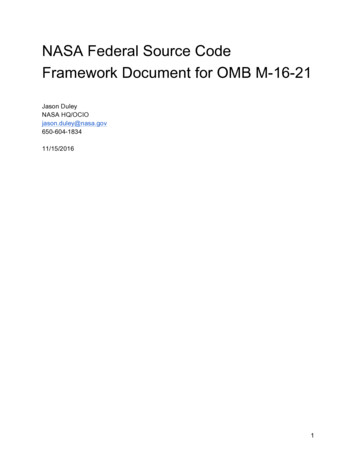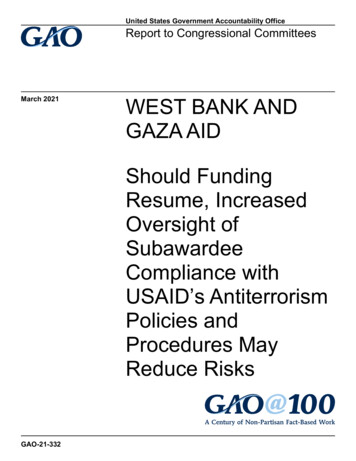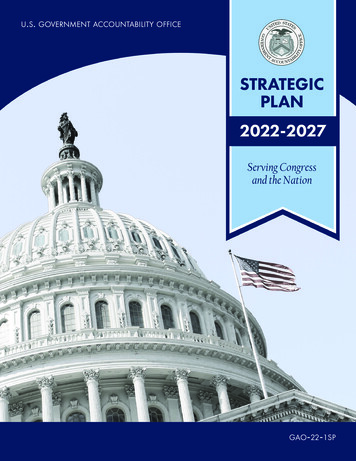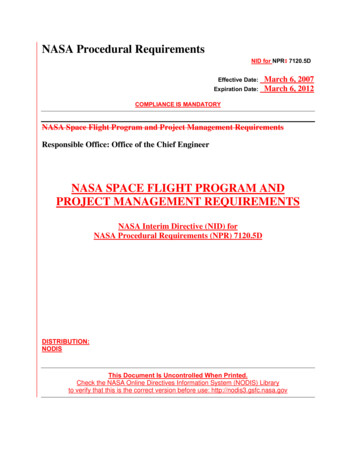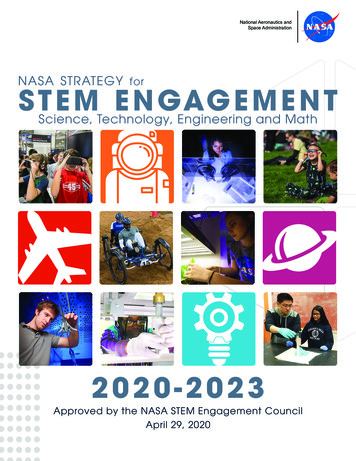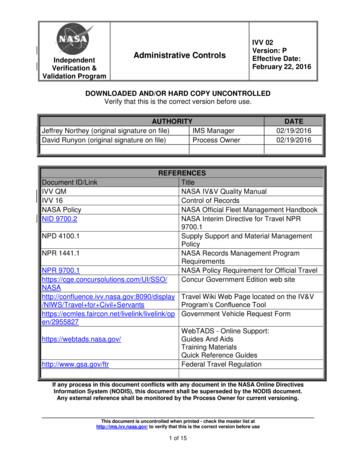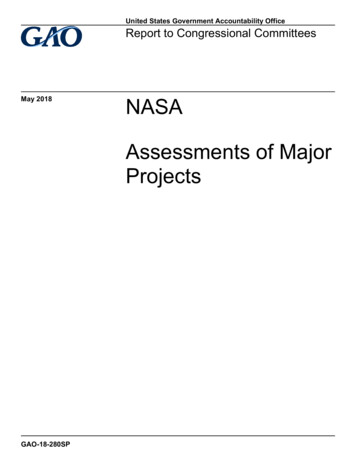
Transcription
United States Government Accountability OfficeReport to Congressional CommitteesMay 2018NASAAssessments of MajorProjectsGAO-18-280SP
May 2018NASAAssessments of Major ProjectsHighlights of GAO-18-280SP, a report tocongressional committeesWhy GAO Did This StudyWhat GAO FoundThis report provides GAO’s annualsnapshot for 2018 of how well NASA isplanning and executing its majoracquisition projects. In May 2017, GAOfound that projects were continuing agenerally positive trend of limiting costand schedule growth, maturingtechnologies, and stabilizing designs.But, at the same time, GAO noted thatmany of these projects, including someof the most expensive ones, wereapproaching the phase in their lifecycles when cost and schedule growthis most likely.The cost and schedule performance of the National Aeronautics and SpaceAdministration’s (NASA) portfolio of major projects has deteriorated, but theextent of cost performance deterioration is unknown. NASA expects cost growthfor the Orion crew capsule—one of the largest projects in the portfolio—but doesnot have a current cost estimate. In addition, the average launch delay for theportfolio was 12 months, the highest delay GAO has reported in its 10 years ofassessing major NASA projects (see figure below).The explanatory statement of theHouse Committee on Appropriationsaccompanying the OmnibusAppropriations Act, 2009 included aprovision for GAO to prepare statusreports on selected large-scale NASAprograms, projects, and activities. Thisis GAO’s 10th annual assessment.This report describes the cost andschedule performance of NASA’sportfolio of major projects, among otherissues. This report also includesassessments of NASA’s 26 majorprojects, each with a life-cycle cost ofover 250 million. To conduct itsreview, GAO analyzed cost, schedule,technology maturity, design stability,and other data; reviewed monthlyproject status reports; and interviewedNASA officials.What GAO RecommendsIn prior reports, GAO has made relatedrecommendations that NASA generallyagreed with, but has not yet fullyaddressed. GAO continues to believethey should be fully addressed. NASAgenerally agreed with GAO’s findings.View GAO-18-280SP. For more information,contact Cristina Chaplain at (202) 512-4841 orchaplainc@gao.gov.NASA’s Major Project Portfolio Cost and Schedule Performance Deteriorated in 2018The deterioration in portfolio performance was the result of 9 of the 17 projects indevelopment experiencing cost or schedule growth. Four projects encountered technical issues that were compounded by riskyprogram management decisions. For example, the Space Launch System andExploration Ground Systems programs are large-scale, technically complexhuman spaceflight programs, and NASA managed them to aggressiveschedules and with insufficient levels of cost and schedule reserves. Thismade it more difficult for the programs to operate within their committedbaseline cost and schedule estimates. Two projects ran into technical challenges that resulted in delays in theintegration and test phase. For example, in December 2017, GAO found thatthe James Webb Space Telescope project encountered delays primarily dueto the integration of the various spacecraft elements taking longer thanexpected, as well as resolving technical issues during testing. GAO haspreviously found that integration and testing is when projects are most at riskof incurring cost and schedule growth. Three projects experienced cost growth or schedule delays due to factorsoutside of the projects’ control, such as delays related to their launch vehicles.NASA continues to face increased risk of cost and schedule growth in futureyears due to new, large and complex projects that will enter the portfolio andexpensive projects remaining in the portfolio longer than expected.United States Government Accountability Office
ContentsLetterAppendix I1BackgroundPortfolio Cost and Schedule Deteriorated but Extent of CostGrowth Is UnknownNASA Generally Maintained Technology Maturity of Its Projectsbut Performance in Design Stability Measures Is MixedToo Early to Determine Outcome of NASA’s Efforts to AddressWorkforce ChallengesProject AssessmentsCommercial Crew ProgramDouble Asteroid Redirection TestEuropa ClipperExploration Ground SystemsGravity Recovery and Climate Experiment Follow-OnIce, Cloud, and Land Elevation Satellite-2Interior Exploration using Seismic Investigations,Geodesy, and Heat TransportIonospheric Connection ExplorerJames Webb Space TelescopeLandsat 9Laser Communications Relay DemonstrationLow Boom Flight DemonstratorLucyMars 2020NASA ISRO – Synthetic Aperture RadarOrion Multi-Purpose Crew VehicleParker Solar ProbePlankton, Aerosol, Cloud, ocean EcosystemPsycheRadiation Budget InstrumentRestore-LSpace Launch SystemSpace Network Ground Segment SustainmentSurface Water and Ocean TopographyTransiting Exoplanet Survey SatelliteWide-Field Infrared Survey TelescopeAgency Comments and Our 97Objectives, Scope, and Methodology100Page i312263543454749515355GAO-18-280SP Assessments of Major NASA Projects
Appendix IIMajor NASA Projects Assessed in GAO’s 2018 Report107Appendix IIIMajor NASA Projects Reviewed in GAO’s Annual Assessments109Appendix IVTechnology Readiness Levels111Appendix VElements of a Sound Business Case113Appendix VIComments from the National Aeronautics and Space Administration 115Appendix VIIGAO Contact and Staff Acknowledgments118TablesTable 1: Major NASA Projects Reviewed in GAO’s 2018Assessment by PhaseTable 2: Development Cost and Schedule Performance ofSelected Major NASA Projects Currently in DevelopmentTable 3: Examples of Risky Programmatic Decisions Made byNASA’s Human Spaceflight ProgramsTable 4: Characteristics of Technology Readiness Levels81518111FiguresFigure 1: NASA’s Life Cycle for Space Flight ProjectsFigure 2: Notional Distribution of Cost Reserves for a ProjectBudgeted at the 70 Percent Confidence LevelFigure 3: NASA’s Workforce Distribution at NASA Headquartersand Centers as of January 2018Figure 4: Development Cost Performance and Average LaunchDelay for Major NASA Projects from 2009 to 2018Figure 5: Number of NASA’s Major Projects Attaining TechnologyMaturity by Preliminary Design Review from 2010 to 2018Page ii35111428GAO-18-280SP Assessments of Major NASA Projects
Figure 6: Average Number of Critical Technologies Reported byNASA’s Major Projects in Development from 2009 to2018Figure 7: Number of NASA Major Projects That Released at least90 Percent of Drawings by Critical Design Review andAverage Percentage of Released Drawings from 2010 to2018Figure 8: Average Percentage of Engineering Drawing Growthafter Critical Design Review for NASA Major Projectsfrom 2010 to 2018Figure 9: NASA’s Workforce Average Age, Retirement Eligibility,and Average Number of Years Worked Past RetirementEligibility as of January 2018Figure 10: Illustration of a Sample Project AssessmentFigure 11: Cost and Schedule of Major NASA Projects Assessedin GAO’s 2018 Report by PhaseFigure 12: Major NASA Projects Reviewed in GAO’s AnnualAssessments from 2009-2017Figure 13: Major NASA Projects Reviewed in GAO’s 2018AssessmentPage iii3032344044107109110GAO-18-280SP Assessments of Major NASA Projects
ENNASANEXT-CNISARNOAAPage ivAsteroid Impact MonitorAdvanced Topographic Laser Altimeter SystemCommercial Crew ProgramCentre National d’Etudes SpatialesDouble Asteroid Redirection Testdata collection instrumentDeep Space Optical CommunicationsExploration Ground SystemsExploration Mission 1Exploration Mission 2European Service ModuleEuropean Space AgencyGround Flight Application SoftwareGerman Research Centre for GeosciencesGuidance, Navigation, and ControlGravity Recovery and Climate Experiment Follow-OnGeosynchronous Satellite Launch VehicleHeat Flow and Physical Properties Probehigh voltage power supplyIce, Cloud, and Land Elevation Satellite-2Ionospheric Connection ExplorerInterior Exploration using Seismic Investigations, Geodesy,and Heat TransportIndian Space Research OrganisationInternational Space Stationjoint cost and schedule confidence levelJet Propulsion LaboratoryJoint Polar Satellite System 2James Webb Space TelescopeKa-band Radar Interferometerkey decision pointLow Boom Flight DemonstratorLaser Communications Relay DemonstrationLaser Ranging InterferometerMars Atmosphere and Volatile EvolutionNational Aeronautics and Space AdministrationNASA’s Evolutionary Xenon Thruster-CommercialNASA ISRO Synthetic Aperture RadarNational Oceanic and Atmospheric AdministrationGAO-18-280SP Assessments of Major NASA Projects
OSEISSGSSSLSSPCSWOTTESSVBBWFIRSTWICNPage vNASA Procedural RequirementsOcean Color InstrumentOrion Multi-Purpose Crew VehicleOrigins-Spectral Interpretation-Resource IdentificationSecurity-Regolith ExplorerParker Solar ProbePlankton, Aerosol, Cloud, ocean EcosystemQuiet Supersonic TechnologyRadiation Budget InstrumentSpace Communication and NavigationSpaceport Command and Control SystemSampling and Caching SystemSolar Dynamics ObservatorySeismic Experiment for Interior StructureSpace Network Ground Segment SustainmentSpace Launch SystemSolar Probe CupSurface Water and Ocean TopographyTransiting Exoplanet Survey SatelliteVery Broad BandWide-Field Infrared Survey TelescopeWorkforce Information Cubes for NASAGAO-18-280SP Assessments of Major NASA Projects
This is a work of the U.S. government and is not subject to copyright protection in theUnited States. The published product may be reproduced and distributed in its entiretywithout further permission from GAO. However, because this work may containcopyrighted images or other material, permission from the copyright holder may benecessary if you wish to reproduce this material separately.Page viGAO-18-280SP Assessments of Major NASA Projects
Letter441 G St. N.W.Washington, DC 20548May 1, 2018Congressional CommitteesThe National Aeronautics and Space Administration (NASA) is planningto invest about 61 billion over the life cycle of its current portfolio of 26major projects—those projects that have a life-cycle cost over 250million. These projects aim to continue exploring Earth and the solarsystem and extend human presence beyond low Earth orbit, among otherthings. This report provides an overview of NASA’s planning andexecution of these major acquisitions—an area that has been on GAO’shigh risk list since 1990. 1 It includes assessments of NASA’s key projectsacross mission areas, such as the Space Launch System for humanexploration, Mars 2020 for planetary science, and Ice, Cloud, and LandElevation Satellite-2 (ICESat-2) for Earth science.The explanatory statement of the House Committee on Appropriationsaccompanying the Omnibus Appropriations Act, 2009 includes a provisionfor us to prepare project status reports on selected large-scale NASAprograms, projects, and activities. 2 This is our 10th annual reportresponding to that mandate. This report assesses (1) the cost andschedule performance of NASA’s portfolio of major projects, (2) thematurity of critical technologies and stability of project designs at keypoints in the development process, and (3) the extent to which NASA isassessing future workforce capacity challenges that may affect its abilityto manage its portfolio of projects. This report also includes individualassessments of 26 major NASA projects. When NASA determines that aproject has an estimated life-cycle cost of over 250 million, we includethat project in our annual review up through launch or completion.To assess the cost and schedule performance, technology maturity, anddesign stability of NASA’s major projects, we collected information onthese areas from projects using a data collection instrument, analyzedprojects’ monthly status reports, interviewed NASA project and1GAO, High-Risk Series: Progress on Many High-Risk Areas, While Substantial EffortsNeeded on Others, GAO-17-317 (Washington, D.C.: Feb. 15, 2017).2See Explanatory Statement, 155 Cong. Rec. H1653, 1824-25 (daily ed., Feb. 23, 2009),on H.R. 1105, the Omnibus Appropriations Act, 2009, which became Pub. L. No. 111-8. Inthis report, we refer to these projects as major projects rather than large-scale projects asthis is the term used by NASA.Page 1GAO-18-280SP Assessments of Major NASA Projects
headquarters officials, and reviewed project documentation. There are 26major projects in total, but the information available depends on where aproject is in its life cycle. 3 For the 17 projects in the implementationphase, we compared cost and schedule estimates as of February 2018 totheir original cost and schedule baselines, identified the number oftechnologies being developed, and assessed their technology maturityagainst GAO-identified acquisition best practices and NASA policy. Wealso compared the number of releasable design drawings at the criticaldesign review against GAO-identified acquisition best practices andanalyzed subsequent design drawings changes. We reviewed historicaldata on cost and schedule performance, technology maturity, and designstability for major projects from our prior reports and compared it to theperformance of NASA’s current portfolio of major projects.To assess the extent to which NASA is assessing future workforcecapacity, we reviewed NASA assessments of technical capabilities andbusiness services, interviewed officials responsible for the assessmentsand implementing recommendations from the assessments, includingofficials within the Office of Human Capital Management, and analyzedworkforce data found in a NASA database. We determined that the datawere sufficiently reliable for our purpose by reviewing responses to datareliability questions from knowledgeable agency officials and the data forobvious errors.Finally, to conduct our 26 project assessments, we analyzed monthlystatus reports and interviewed project officials to identify major sources ofrisk and the strategies that projects are using to mitigate them. Appendix Icontains detailed information on our scope and methodology.We conducted this performance audit from April 2017 to May 2018 inaccordance with generally accepted government auditing standards.Those standards require that we plan and perform the audit to obtainsufficient, appropriate evidence to provide a reasonable basis for ourfindings and conclusions based on our audit objectives. We believe that3Eight projects were in an early stage of development, called formulation, when there arestill unknowns about requirements, technology, and design. For those projects, wereported preliminary cost ranges and schedule estimates. The Commercial Crew Programhas a tailored project life cycle and project management requirements. As a result, it wasexcluded from our cost and schedule performance, technology maturity, and designstability analyses.Page 2GAO-18-280SP Assessments of Major NASA Projects
the evidence obtained provides a reasonable basis for our findings andconclusions based on our audit objectives.BackgroundThe life cycle for NASA space flight projects consists of two phases—formulation, which takes a project from concept to preliminary design, andimplementation, which includes building, launching, and operating thesystem, among other activities. NASA further divides formulation andimplementation into phase A through phase F. Major projects must getapproval from senior NASA officials at key decision points before theycan enter each new phase. Figure 1 depicts NASA’s life cycle for spaceflight projects.Figure 1: NASA’s Life Cycle for Space Flight ProjectsProject formulation consists of phases A and B, during which the projectsdevelop and define requirements, cost and schedule estimates, and thesystem’s design for implementation. NASA Procedural Requirements7120.5E, NASA Space Flight Program and Project ManagementRequirements, specifies that during formulation, the project mustcomplete a formulation agreement to establish the technical andacquisition work that needs to be conducted during this phase and definethe schedule and funding requirements for that work. The formulationPage 3GAO-18-280SP Assessments of Major NASA Projects
agreement should identify new technologies and their planneddevelopment, the use of heritage technologies, risk mitigation plans, andtesting plans to ensure that technologies will work as intended in arelevant environment. Prior to entering phase B, projects develop a rangeof the project’s expected cost and schedule which is used to inform thebudget planning for that project. During phase B, the project alsodevelops programmatic measures and technical leading indicators, whichtrack various project metrics such as requirement changes, staffingdemands, and mass and power utilization. Near the end of formulation,leading up to the preliminary design review, the project team completestechnology development and its preliminary design.Formulation culminates in a review at key decision point C, known asproject confirmation, where cost and schedule baselines are establishedand documented in a decision memorandum. The decision memorandumoutlines the management agreement and the agency baselinecommitment. The management agreement can be viewed as a contractbetween the agency and the project manager. The project manager hasthe authority to manage the project within the parameters outlined in theagreement. The agency baseline commitment includes the cost andschedule baselines against which the agency’s performance on a projectmay be measured.To inform the management agreement and the agency baselinecommitment, each project with a life-cycle cost estimated to be greaterthan 250 million must also develop a joint cost and schedule confidencelevel (JCL). The JCL initiative, adopted in January 2009, produces apoint-in-time estimate that includes, among other things, all cost andschedule elements in phases A through D, incorporates and quantifiesknown risks, assesses the impacts of cost and schedule to date, andaddresses available annual resources. NASA policy requires that projectsbe baselined and budgeted at the 70 percent confidence level and fundedat a level equivalent to at least the 50 percent confidence level. 4The management agreement and agency baseline commitment includecost and schedule reserves held at the project and NASA headquarters4NASA Procedural Requirements (NPR) 7120.5E, NASA Space Flight Program andProject Management Requirements paras 2.4.4 and 2.4.4.2 (Aug. 14, 2012) (hereinaftercited as NPR 7120.5E (Aug. 14, 2012)). The decision authority for a project can approve itto move forward at less than the 70 percent confidence level. That decision must bejustified and documented.Page 4GAO-18-280SP Assessments of Major NASA Projects
level, respectively. 5 Cost reserves are for costs that are expected to beincurred—for instance, to address project risks—but are not yet allocatedto a specific part of the project. Schedule reserves are extra time inproject schedules that can be allocated to specific activities, elements,and major subsystems to mitigate delays or address unforeseen risks.Project-held cost and schedule reserves are within the project manager’scontrol. If the project requires additional time or money beyond themanagement agreement—for example, if a project needs additional fundsfor an issue outside of the project’s control—NASA headquarters mayallocate headquarters-held reserves. Figure 2 notionally depicts howNASA would distribute cost reserves for a project that was baselined inaccordance with its JCL policy.Figure 2: Notional Distribution of Cost Reserves for a Project Budgeted at the 70Percent Confidence LevelThe total amount of cost and schedule reserves held at the project levelvaries based on where the project is in its life cycle. Seven NASA centersor laboratories are responsible for managing 25 NASA major projects. Ofthese, four centers or laboratories manage 20 of the 25 major projects5NASA refers to cost reserves as unallocated future expenses.Page 5GAO-18-280SP Assessments of Major NASA Projects
and require or recommend that projects hold a certain level of cost andschedule reserves at key project milestones. 6 For example, at theGoddard Space Flight Center, projects are required to hold cost reservesequal to at least 25 percent of the estimated cost remaining at the projectconfirmation review, and 10 percent at the time of delivery to the launchsite. Projects track their reserves between phases to help ensure theyhold reserves consistent with these requirements. The 26th major projectincluded in our review, the Low Boom Flight Demonstrator (LBFD), doesnot have a lead center because it is using a virtual project office model.Project officials said they have not yet determined which center cost andschedule guidelines the project will follow.After a project is confirmed, it begins implementation, consisting ofphases C, D, E, and F. In this report, we refer to projects in phase C andD as being in development. A critical design review is held during thelatter half of phase C in order to determine if the design is mature enoughto support proceeding with the final design and fabrication. After thecritical design review and just prior to beginning phase D, the projectcompletes a system integration review to evaluate the readiness of theproject and associated supporting infrastructure to begin systemassembly, integration and test. In phase D, the project performs systemassembly, integration, test, and launch activities. Phases E and F consistof operations and sustainment and project closeout.NASA Projects Reviewedin GAO’s AnnualAssessmentNASA’s portfolio of major projects ranges from satellites equipped withadvanced sensors to study the Earth to a rover that plans to collect soil orrock samples on Mars to telescopes intended to explore the universe tospacecraft to transport humans and cargo beyond low-Earth orbit. WhenNASA determines that a project will have an estimated life-cycle cost ofmore than 250 million, we include that project in our annual review. After6Goddard Procedural Requirements 7120.7A, Schedule and Budget Margins for FlightProjects (Feb. 28, 2017); Marshall Procedural Requirements 7120.1, Marshall SpaceFlight Center Engineering and Program/Project Management Requirements (Aug. 26,2014); Langley Research Center, Space Flight Project Practices Handbook, LPR 7120.5B-1 (Mar. 17, 2014); and Jet Propulsion Laboratory, Flight Project Practices, Rev. 8 (Oct.6, 2010). The Kennedy Space Center and Johnson Space Center do not have centerspecific guidance for reserves. The Johns Hopkins University Applied Physics Laboratorymanages the Parker Solar Probe (PSP) and Double Asteroid Redirection Test (DART)projects and has guidelines for schedule reserves, but not for cost reserves. The JohnsHopkins University Applied Physics Laboratory SD-QP-012, Rev. b, Space ExplorationSector (SES) Quality Procedure: Earned Value Management System (EVMS) ProjectManagement Control System (PMCS) (Apr. 4, 2017).Page 6GAO-18-280SP Assessments of Major NASA Projects
a project launches or reaches full operational capability, we no longerinclude an assessment of it in our annual report.This report includes assessments of 26 major NASA projects (see table1). Six projects are being assessed for the first time this year: DoubleAsteroid Redirection Test (DART), Laser Communications RelayDemonstration (LCRD), LBFD, Lucy, Psyche, and Restore-L. Prior toestablishing its cost baseline, the LCRD project had an estimated lifecycle cost estimate of less than 250 million and therefore was notincluded in our previous reviews when the project was in formulation. Fora list of the 26 projects and their current cost and schedule estimates, seeappendix II. We did not complete an assessment for the Asteroid RedirectRobotic Mission project this year because, as of June 2017, the projectclosed out most project development activities at the direction of NASAheadquarters. Appendix III includes a list of all the projects that we havereviewed from 2009 to 2017.Page 7GAO-18-280SP Assessments of Major NASA Projects
Table 1: Major NASA Projects Reviewed in GAO’s 2018 Assessment by PhaseProjects in formulationDouble Asteroid Redirection Test (DART)Europa ClipperLow Boom Flight Demonstrator (LBFD)LucyPlankton, Aerosol, Cloud, ocean Ecosystem (PACE)PsycheRestore-LWide-Field Infrared Survey Telescope (WFIRST)Projects in implementationCommercial Crew Program (CCP)Exploration Ground Systems (EGS)Gravity Recovery and Climate Experiment Follow-On(GRACE-FO)Ice, Cloud, and Land Elevation Satellite-2 (ICESat-2)Interior Exploration using Seismic Investigations,Geodesy, and Heat Transport (InSight)Ionospheric Connection Explorer (ICON)James Webb Space Telescope (JWST)Landsat 9 (L9)Laser Communications Relay Demonstration (LCRD)Mars 2020NASA ISRO Synthetic Aperture Radar (NISAR)Orion Multi-Purpose Crew Vehicle (Orion)Parker Solar Probe (PSP) (formerly Solar Probe Plus)Radiation Budget Instrument (RBI)Space Launch System (SLS)Space Network Ground Segment Sustainment (SGSS)Surface Water and Ocean Topography (SWOT)Transiting Exoplanet Survey Satellite (TESS)Source: GAO analysis of National Aeronautics and Space Administration data. GAO-18-280SPPage 8GAO-18-280SP Assessments of Major NASA Projects
Over the past 6 years, we have issued several reports assessing NASA’sprogress acquiring its largest projects and programs in more depth. 7 Wefound in July 2016 that all three human spaceflight programs—the OrionMulti-Purpose Crew Vehicle (Orion), the Space Launch System (SLS),and Exploration Ground Systems (EGS)—were making progress inresolving technical issues and maturing designs, but that pressure on thelimited cost and schedule reserves put the schedule for their firstcombined mission, the uncrewed Exploration Mission-1 (EM-1), at risk. 8Subsequently, in April 2017, we found that given the combined effects ofongoing technical challenges in conjunction with limited cost andschedule reserves, it was unlikely that these programs would achieve theplanned November 2018 launch readiness date. 9 We recommended thatNASA confirm whether this launch readiness date was achievable and, ifwarranted, propose a new, more realistic EM-1 date and report toCongress on the results of its schedule analysis. NASA agreed with bothrecommendations and stated that it was no longer in its best interest topursue the November 2018 launch readiness date. In December 2017,7GAO, James Webb Space Telescope: Actions Needed to Improve Cost Estimate andOversight of Test and Integration, GAO-13-4 (Washington, D.C.: Dec. 3, 2012); SpaceLaunch System: Resources Need to be Matched to Requirements to Decrease Risk andSupport Long Term Affordability, GAO-14-631 (Washington, D.C.: July 23, 2014); JamesWebb Space Telescope: Project Meeting Commitments but Current Technical, Cost, andSchedule Challenges Could Affect Continued Progress, GAO-14-72 (Washington, D.C.:Jan. 8, 2014); James Webb Space Telescope: Project Facing Increased Schedule Riskwith Significant Work Remaining, GAO-15-100 (Washington, D.C.: Dec. 15, 2014); SpaceLaunch System: Management Tools Should Better Track to Cost and ScheduleCommitments to Adequately Monitor Increasing Risk, GAO-15-596 (Washington, D.C.:July 16, 2015); James Webb Space Telescope: Project on Track but May Benefit fromImproved Contractor Data to Better Understand Costs, GAO-16-112 (Washington, D.C.:Dec. 17, 2015);NASA Human Space Exploration: Opportunity Nears to Reassess LaunchVehicle and Ground Systems Cost and Schedule, GAO-16-612 (Washington, D.C.: July27, 2016); Orion Multi-Purpose Crew Vehicle: Action Needed to Improve Visibility intoCost, Schedule, and Capacity to Resolve Technical Challenges, GAO-16-620(Washington, D.C.: July 27, 2016); NASA Commercial Crew Program: Schedule PressureIncreases as Contractors Delay Key Events, GAO-17-137 (Washington, D.C.: Feb. 16,2017); NASA Human Space Exploration: Delay Likely for First Exploration Mission,GAO-17-414 (Washington, D.C.: Apr. 27, 2017); NASA Human Space Exploration:Integration Approach Presents Challenges to Oversight and Independence, GAO-18-28(Washington, D.C.: Oct 19, 2017); NASA Commercial Crew Program: Continued DelaysPose Risks for Uninterrupted Access to the International Space Station, GAO-18-317T(Washington, D.C.: Jan. 17, 2018); and James Webb Space Telescope: Integration andTest Challenges Have Delayed Launch and Threated to Push Costs Over Cap,GAO-18-273 (Washington, D.C.: Feb. 28, 2018).8GAO-16-620 and GAO-16-612.9GAO-17-414.Page 9GAO-18-280SP Assessments of Major NASA Projects
NASA approved a new EM-1 schedule of December 2019, with sixmonths of schedule reserve available to extend the date to June 2020. InApril 2018, NASA provided us with the letter the agency sent to Congresson its assessment of the EM-1 schedule. We are in the process ofreviewing the letter to determine if it addresses our recommendation.We have also reported for several years on the James Webb SpaceTelescope (JWST) project, which has experienced significant costincreases and schedule delays. Prior to being approved for development,cost estimates for JWST ranged from 1 billion to 3.5 billion, withexpected launch dates ranging from 2007 to 2011. Before 2011, earlytechnical and management challenges, contractor performance issues,low levels of cost reserves, and poorly phased funding levels causedJWST to delay work after confirmation, which contributed to significantcost and schedule overruns, including launch delays. Following anindependent review that found JWST was executing well from a technicalstandpoint, but that the baseline cost estimate did not reflect the mostprobable cost with adequate reserves in each year of project execution,Congress placed a
The cost and schedule performance of the National Aeronautics and Space Administration's (NASA) portfolio of major projects has deteriorated, but the extent of cost performance deterioration is unknown. NASA expects cost growth for the Orion crew capsule—one of the largest projects in the portfolio—but does not have a current cost estimate.
